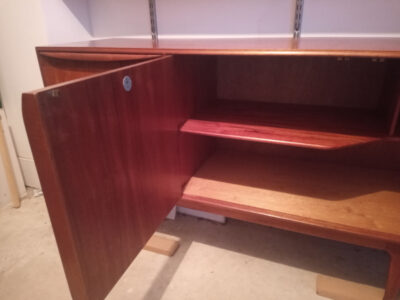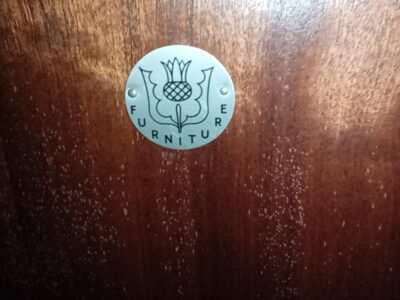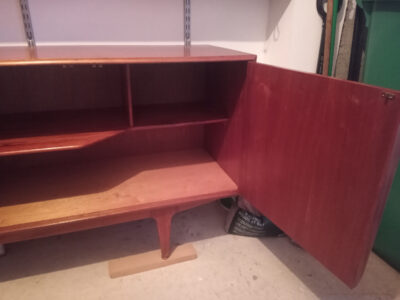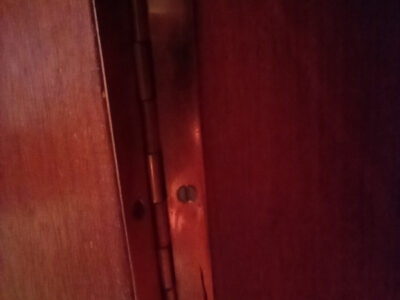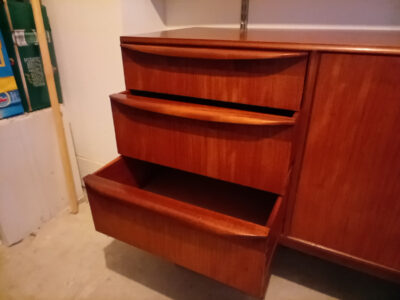
McIntosh Sideboard Models – My Lomond McIntosh Sideboard
Thanks for visiting and thanks if you have helped me identify my McIntosh sideboard as a ‘short’ Lomond.
What I do know is that the sideboard was bought in Stirling in 1960 as a wedding present for my parents. As I hope you can see from the images it is in near perfect condition and has never had any work carried out on it. My parents are both amazed how well it fared considering it sat in our lounge all the time my brother and I were growing up. In fact it is only in the last 10 years that it has made it way to the garage to make way for an inferior replacement. My parents do live in Kirkcaldy though so it does feel like the sideboard has come home!
Dimensions of McIntosh Sideboard – Short Lomond
Height 76 cm x Width 152 cm x Depth 45 cm.
Height 30 inches x Width 60 inches x Depth 18 inches.
Thanks for Helping me Identify The Model of McIntosh Sideboard?
At first I thought the sideboard was a short version of the ‘Moy’ sideboard which itself looks like a short version of the Dunvegan sideboard. It looks fairly similar but now, with the help of Ed McColl of Brickhouse Vintage, it appears to be a short version of the Lomond McIntosh Sideboard.
I thought the wood was teak but according to a catalogue he had it is made from Mahogany with Rose Zebrano fronts inlaid with Rosewood.
If the sideboard had been a ‘Moy’ then it would have been designed by Tom Robertson in 1960 and had a production period of 1960 to 1969 making my sideboard one of the first produced. However, the new information means I am still not sure of the design/production period. It was certainly purchased in 1960 so if anyone can help me narrow down details of the design I would appreciate it.
The Short Lomond Sideboard by McIntosh Found Elsewhere Online
I have found what I think is the same or similar sideboard at the following sites online. Most are saying that the wood is Teak though so it would be great to have confirmation.
If you can help me with any information regarding my McIntosh Sideboard then please email me by clicking the button.
- McIntosh Sideboard with left door open
- McIntosh Furniture Label
- McIntosh Sideboard with right door open
The History of McIntosh Sideboards
McIntosh sideboards hold a distinguished place in the world of furniture design, renowned for their craftsmanship, quality, and timeless elegance. The history of McIntosh sideboards traces back to the mid-20th century, when a Scottish furniture company, Thomas Robertson & Sons Ltd., embarked on a journey that would ultimately redefine the standards of British furniture manufacturing.
Founded in the late 1860s, Thomas Robertson & Sons initially focused on crafting high-quality cabinets and occasional pieces. However, it wasn’t until the mid-20th century that the company, under the visionary leadership of Tom Robertson, began to take a more modern and innovative approach to their designs. This marked the inception of the McIntosh range, named after Tom’s wife’s maiden name.
- Piano Hinge Outside
- Piano Hinge Inside
- McIntosh Sideboard Drawers
- McIntosh Sideboard Drawers
The 1950s and 1960s were pivotal decades for McIntosh sideboards. This period witnessed a surge in demand for modern, sleek, and functional furniture, driven by a growing middle class with an inclination towards contemporary interior design. McIntosh deftly responded to this demand, producing a range of sideboards that seamlessly combined form and function.
One of McIntosh’s distinctive features was their use of teak, a rich, durable hardwood that not only exuded a warm, natural aesthetic but also showcased the company’s commitment to using premium materials. The sideboards were characterized by clean lines, organic shapes, and a minimalist aesthetic, which perfectly embodied the mid-century modern design ethos.
In addition to teak, McIntosh sideboards often featured rosewood accents, which added a touch of luxury to their creations. These sideboards were known for their exceptional attention to detail, with carefully crafted joinery, precision-cut veneers, and expertly finished surfaces. This commitment to quality solidified McIntosh’s reputation as a leading manufacturer of high-end furniture.
As the 1970s approached, McIntosh sideboards continued to evolve, incorporating elements of Scandinavian design, which emphasized simplicity, functionality, and a connection to nature. This fusion of British craftsmanship with Scandinavian influences contributed to the enduring appeal of McIntosh furniture.
Throughout the 1970s and 1980s, McIntosh maintained its position as a prominent player in the furniture industry, catering to an international clientele that appreciated the brand’s commitment to quality and design excellence. However, with changing tastes and shifting trends in the late 20th century, McIntosh, like many other furniture manufacturers, faced challenges.
Today, McIntosh sideboards have experienced a resurgence in popularity, fueled by a renewed interest in mid-century modern design. Collectors and enthusiasts alike seek out these pieces for their timeless appeal, exceptional craftsmanship, and historical significance.
In conclusion, the history of McIntosh sideboards is a testament to the enduring legacy of a Scottish furniture company that elevated the standards of British craftsmanship. With their use of premium materials, attention to detail, and commitment to modern design, McIntosh sideboards continue to be cherished and sought after by those who appreciate the fusion of form and function in furniture design. Their legacy endures as a symbol of mid-century modern excellence in the world of interior furnishings.
